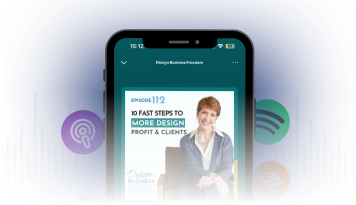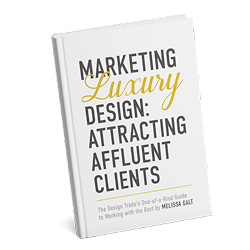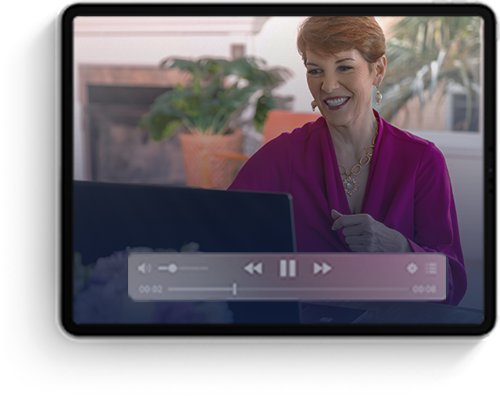Smart Pricing Strategies for Interior Designers
Pricing for interior designers isn’t just a topic—it’s a trigger. It brings up fear, doubt, and imposter syndrome faster than just about anything else in your design business. But here’s the truth, when your interior design pricing aligns with your value, everything changes.
EPISODE HIGHLIGHTS
02:15 – “The cost of pricing fails – New designers undercharging by 50–75%”
10:30 – “Money = pass the salt – Detach emotions from pricing”
17:15 – “You’re not here to be affordable – Shift to being appropriate in value”
28:00 – “Flat fees + value-based = scalable success”
47:00 – “Lifetime benefit, not one-time transaction – Building lasting client relationships”
Pricing isn’t about gouging. It’s about grounding. It’s about standing firmly in your worth and building a business that supports the life you want.
Here’s how to do just that.
How to Charge for Interior Design: When You Get Pricing Wrong
At a recent Design Edge event, two new designers approached me. They had each priced recent projects at $3 per square foot. Both projects were residential 2K square feet with different scopes of work for each.
One was working on a new build and was handling finishes, fixtures, and lighting. That should’ve come in at $7–$10/sq ft minimum. So she left 50-75% of her fee on the table charging $3 per square foot.
The second was furnishings for a two-bedroom home which should have been $10-$15/square foot because it included some lighting and finishes. The client’s initial investment was intended to be $30k, then they sliced it in half to $15K. A designer would have a hard time fulfilling that client even with Wayfair. In this case, it would have been better for the designer to say, “we’re not the best fit for your design needs and refer them to other design firms or the free design at Ethan Allen, Arhaus, or Lazy Boy.
Clients of mine who are a 7-figure firm and accustomed to earning on product only, have added, at my urging and with my guidance design fees, their first project with design fees, they asked for half or one-third of what was appropriate because it was new and they felt uncomfortable. In just three short months, they’ve realized why they deserved the full design fee and the clients would have gladly invested in it. NOTICE MY WORD CHOICES.
When you undervalue, when you underbill, when you discount your invoices because you’re worried that the client will question it or will push back, you are compromising the priceless value of your talent, your transformations, and of design. YOU DESERVE BETTER ALWAYS. YOU DESERVE TO BE WELL COMPENSATED ALWAYS.
Why Interior Design Pricing Feels So Personal
If you’re discounting invoices out of fear, you’re compromising your talent—and the transformation you deliver.
I’ve worked with solopreneurs and firms with teams of 15. When they bill hourly, they all fall into the same trap: they discount.
It’s time to do it differently.
Take the emotion out of it. Money is not emotional—unless you make it so.
Write this on a sticky note: Pass the salt. That’s how neutral pricing should be.
Design fees should be part of the investment—not added on later.
When you price from fear, you lose. When you price from alignment, you win—and so does your client.
If your clients are telling you to raise your rates, listen. That’s your sign. You’re undervalued.
Price for Your Design Process, Not for Affordability
There’s no universal model—but there is your model for pricing interior design services.
Design is lucrative—if you let it be. If it feels hard, you’re likely making it harder than it needs to be.
If you’ve ever thought, “I hope they can afford me,”—stop.
You’re not here to be affordable. You’re here to be appropriate in value.
Your pricing should reflect your strengths, your experience, your talent and your vision.
Years ago, I raised my rate from $65 to $75/hour and lost a client. Her husband was a senior VP at UPS—money wasn’t the issue. Perceived value was.
Later, I was told I was the highest-priced designer in Atlanta at $200/hour. I wasn’t. But I didn’t correct him. I didn’t get the job either. And that was fine. He fired the designer he did hire. Not all plum jobs are plums. Some are bullets you dodge.
Interior Design Pricing Models That Scale
Let’s look at the options for pricing in your interior design business—and why some work better than others.
Hourly
I want you out of this model as fast as humanly possible. It limits growth. Unless you’re charging $450–$1,500/hour (and most aren’t), it’s a cap.
Flat Fee
Clear. Predictable. Scalable. This is what I teach—whether by square foot, percentage of project cost, or room-by-room. Adapt to fit the project.
Value-Based
This is included in flat fees. Your work delivers daily transformation and joy. That’s the value.
Your target profit margin should be 35–45%. If you don’t know what you’re making, please fix that. Hire a provider who delivers monthly P&Ls and keeps you informed on your tax liability. Add a financial advisor—even if you start small. It matters.
Package the Transformation, Not the Time
Avoid selling hours, instead sell transformation.
✔ Package your services—by room, by tier, or by occasion.
✔ Capture both partners’ birthdays and emails—those are opportunity gold.
✔ Specialize. When you go deep, not wide, you earn more and serve better.
Still juggling new builds, remodels, and furnishings? Ask yourself what lights you up. Let the rest go. You’re allowed to reset. You’re allowed to pivot.
Instead of selling hours, sell solutions and transformations.
Package Your Value Creatively – By The Room, By the Level, By the Home, For the Occasion … The Graduation Package, The Anniversary Special, The Birthday Bonus (those last three make great gift certificates)
Be a Specialist vs. a Generalist, they earn more always. You can specialize by style (Maximalism, Minimalism, Vintage Modern, Cozy Cottage, you get the idea) by room (Kitchen & Bath, Home Theatre, Specialty Rooms, Kids Rooms), by design element (Drapery, Accessories & Artwork, Lighting), or by service specialty (New Build, Remodeling, Furnishings Only)
Stop creating a transaction and focus on the value of the transformation. A transaction is one and done and you want to become a lifetime benefit for your clients.
Raise Your Interior Design Rates
Installations should be celebrations. The end of a project isn’t the end of the relationship. Stay in touch. Be a lifetime benefit to your clients—not a one-time transaction.
Need to raise your rates? If you’re hourly, you’ll need to announce it. If you’re flat-fee, you can raise them quietly with each new project. If you’re fully booked with no pushback, you’re not priced high enough. Watch your client’s face when you review your agreement. If there’s zero hesitation, it’s time to raise your rates.
Want a quick cash windfall when moving from hourly to flat fee? Offer a limited-time block of hours—good for six months. Create three clear packages (A, B, and C), give them names, and don’t leave it open-ended. Avoid the “scrambled egg” projects. Set the structure. Let clients choose from it.
Key Takeaways
You’ve learned a lot here, now it’s time to apply it.
✔ Clean up your pricing structure
✔ Detach emotions—make pricing neutral
✔ Stop discounting and undercharging
✔ Choose flat fee over hourly
✔ Know your numbers and profit margin
✔ Package services around transformation
✔ Specialize to attract ideal clients
✔ Prioritize long-term relationships
✔ Raise your rates as needed
Stop doing business the way others do. Do it your way. Build the business you want. One that reflects your value—and supports your life.
If you’re serious about growth and ready to take action, coaching will accelerate your success. It starts with a confidential Design Business Assessment—a complimentary session where we’ll take a close look at your design practice, where you are, and where you want to be. We’ll put together a plan to close the gap.





